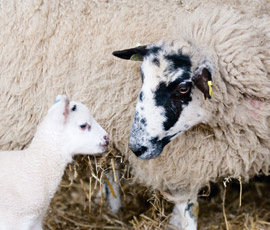Thin ewes could be sign of fluke

As lambing approaches, the Sustainable Control of Parasites in Sheep (SCOPS) group is urging sheep farmers to check ewe body condition and continue the fight against liver fluke this winter.
With widespread reports of thin ewes up and down the UK and confirmed cases of liver fluke disease increasing exponentially, nobody can afford to drop their guard, says sheep farmer and SCOPS chairman Peter Baber.
“While there are a number of reasons why ewes may be thin, a liver fluke burden is still a major risk factor.
The challenge from high levels of liver fluke on pasture continued throughout the first two months of 2013 and many farmers seem unaware that if sheep are put back on high-risk pastures they will need to be retreated with a flukicide five to six weeks later to avoid losses.
This means treatments are required more frequently than farmers are used to and SCOPS suspects that there is also confusion because some products used are persistent against worms, but not against liver fluke.
In addition to making sure additional treatments are given if required, SCOPS advises sheep farmers to:
- Check ewe body condition and identify thin ewes now – look for symptoms such as bottle jaw.
- Segregate thin ewes and increase feed levels according to a forage analysis. Even though treatment may have removed the parasites, some ewes will have badly damaged livers and will need additional inputs to get them through lambing.
- Follow up any sheep going direct to an abattoir. Ask for feedback and if livers are rejected, find out why.
- Investigate losses and other possible causes of thin ewes – ask your vet to carry out post-mortem examinations on deaths and discuss actions to minimise losses in the run up to lambing.
- Make sure clostridial vaccinations are up to date; Black Disease is a major risk where livers have been damaged by fluke.
SCOPS also says farmers need to start planning ahead now to minimise the impact of liver fluke next season. Lesley Stubbings, independent sheep consultant and member of the SCOPS Steering Group, says: “We don’t know what the weather will bring this year, but there are some steps farmers should be taking which will limit the damage later in 2013 and into 2014.”
These are:
- Reduce the amount of pasture contamination this spring by using a treatment that kills any adult liver fluke that have survived in the sheep. Consult your vet or adviser to make sure you choose the right product.
- Implement management controls where possible. These include identifying the high risk areas on the farm and putting measures in place that will avoid them. Practical steps include fencing off wet areas and attending to leaking troughs, pipes and drainage.
- Plan to test that your flukicide is working. On high risk farms where triclabendazole (TCBZ) has been heavily relied on it is vital to check that it is still working effectively. While there is some resistance to this treatment it remains an important weapon against immature fluke and SCOPS is concerned that many people have mistaken re-infection this winter with treatment failure.
Test your knowledge on liver fluke control on our online academies page
